Cryptosporidiosis
Cryptosporidiosis (also referred to as Crypto) is a gastrointestinal illness that results from exposure to the organism Cryptosporidium parvum ( C. parvum ). Cryptosporidiosis rose to public attention in the United States in 1993 when more than 100 people died and more than 400,000 people were sickened by Crypto in Milwaukee, Wisconsin.
Cryptosporidiosis is primarily a waterborne illness. People get infected from drinking inadequately treated drinking water, or from swallowing or drinking untreated water from a lake, stream, or swallowing water from a recreational swimming pool. People can become infected with Crypto through contact with the contaminated fecal matter of humans or animals carrying the organism, usually by swallowing food or liquid that has had contact with the contaminated fecal matter. Children at day care centers, day care workers, and health care workers interacting with infected individuals must be vigilant about sanitation to reduce the spread of the organism. Unwashed fruits and vegetables that have been in contact with Cryptoinfected soil have also exposed people to the organism. Cattle and calves contribute significant amounts of Crypto to soils and adjacent water bodies; and wild animals such as elk, deer, bear, and beaver can also carry and spread the organism.
Crypto's symptoms in humans are not unique. They include upset stomach, diarrhea, cramps, weight loss, dehydration, and sometimes fever. Some people do not experience any symptoms. The effects of cryptosporidiosis can be fatal for immunocompromised individuals, including AIDS and cancer patients. Cryptosporidiosis can only be diagnosed by testing a person's stool for the parasite. There is currently no treatment for the illness, which can last several days to a few weeks in healthy individuals.
The organism, C. parvum, is miniscule. It is 3 to 5 microns in size, while the diameter of a human hair is 50 to 200 microns. Giardia lamblia, another significant waterborne parasite, is 5 to 7 microns in size.
Drinking water regulations that went into effect in 1990 focused on the removal and inactivation of Giardia. The threat of Giardia is removed by common water treatment practices, including filtration and disinfection with chlorine. These treatment practices are not as effective against Crypto, which is half the size of Giardia and resistant to disinfection with chlorine. Because drinking water containing Cryptosporidium is difficult to treat, it is important to protect the source of the water against animal waste runoff and other sources of Crypto contamination. Water treatment regulations in effect in 2002 require water utilities to improve treatment plant performance and consistency against Cryptosporidium. The revised drinking water regulations only address exposure from public drinking water sources; they do not address recreational waterborne exposure, or other routes of exposure that tend to be more common.
SEE ALSO H EALTH , H UMAN ; R ISK ; W ATER P OLLUTION ; W ATER T REATMENT .
Bibliography
American Water Works Association. (1990). Water Quality and Treatment: A Handbook of Community Water Supplies, 4th edition. San Francisco: McGraw-Hill.
American Water Works Association and the Society of Civil Engineers. (1998). Water Treatment Plant Design, 3rd edition. San Francisco: McGraw-Hill.

Internet Resource
U.S. Environmental Protection Agency, Office of Water. Available from http://www.epa.gov/safewater .
Julie Hutchins Cairn
Comment about this article, ask questions, or add new information about this topic: